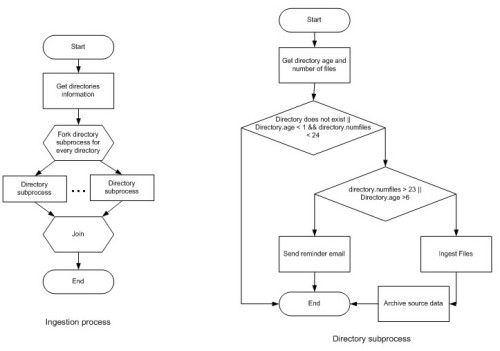跟着示例学Oozie
在前一篇文章《Oozie简介》中,我们已经描述了Oozie工作流服务器,并且展示了一个非常简单的工作流示例。我们还描述了针对Oozie的工作流的部署和配置,以及用来启动、停止和监控Oozie工作流的工具。
在本文中,我们会描述一个更加复杂的例子,通过它我们可以讨论更多Oozie特性,并演示如何来使用它们。
定义过程
我们在此描述的工作流会实现汽车GPS探测数据的获取过程。我们每个小时都会以文件的形式把探测数据传递到指定的HDFS目录中[1],其中包含有这个小时之内的所有探测数据。探测数据的获取是每天针对一天内所有的24个文件完成的。如果文件的数量是24,那么获取过程就会启动。否则:
(点击可以查看大图)。
图1: 过程图
在此,主流程(数据获取流程)首先会为今天以及之前的六天计算出目录的名称,然后启动(fork)七个目录的子过程(子流程)。待所有子过程的状态都变成终止之后,join步骤就会把控制权交给end状态。
子过程启动时,首先会获得关于目录的信息——它的日期以及文件数量。基于这条信息,它会决定是获取数据还是把数据归档,或者发送剩下的邮件,或者不做任何工作。
Directory子过程实现
以下代码负责实现的是directory子过程(代码1)。
代码1: Directory子过程
这个子过程的start节点会触发自定义的java节点,这个节点会获得目录信息(代码2)。
package com.navteq.oozie;
import java.io.File;
import java.io.FileOutputStream;
import java.io.OutputStream;
import java.util.GregorianCalendar;
import java.util.Properties;
import org.apache.hadoop.conf.Configuration;
import org.apache.hadoop.fs.FileStatus;
import org.apache.hadoop.fs.FileSystem;
import org.apache.hadoop.fs.Path;
public class GetDirInfo {
private static final String OOZIE_ACTION_OUTPUT_PROPERTIES = "oozie.action.output.properties";
public static void main(String[] args) throws Exception {
String dirPath = args[0];
String propKey0 = "dir.num-files";
String propVal0 = "-1";
String propKey1 = "dir.age";
String propVal1 = "-1";
System.out.println("Directory path: '"+dirPath+"'");
Configuration conf = new Configuration();
FileSystem fs = FileSystem.get(conf);
Path hadoopDir = new Path(dirPath);
if (fs.exists(hadoopDir)){
FileStatus[] files = FileSystem.get(conf).listStatus(hadoopDir);
int numFilesInDir = files.length;
propVal0 = Integer.toString(numFilesInDir);
long timePassed, daysPassedLong;
int daysPassed;
String dirName = hadoopDir.getName();
String[] dirNameArray = dirName.split("-");
if (dirNameArray.length == 3) {
int year = Integer.valueOf(dirNameArray[0]);
int month = Integer.valueOf(dirNameArray[1]) - 1; //months are 0 based
int date = Integer.valueOf(dirNameArray[2]);
GregorianCalendar dirCreationDate = new GregorianCalendar(year,
month, date);
timePassed = (new GregorianCalendar()).getTimeInMillis()
- dirCreationDate.getTimeInMillis();
daysPassed = (int) = timePassed / 1000 / 60 / 60 / 24;;
propVal1 = Integer.toString(daysPassed);
}
}
String oozieProp = System.getProperty(OOZIE_ACTION_OUTPUT_PROPERTIES);
if (oozieProp != null) {
File propFile = new File(oozieProp);
Properties props = new Properties();
props.setProperty(propKey0, propVal0);
props.setProperty(propKey1, propVal1);
OutputStream os = new FileOutputStream(propFile);
props.store(os, "");
os.close();
} else
throw new RuntimeException(OOZIE_ACTION_OUTPUT_PROPERTIES
+ " System property not defined");
}
}
代码2: 获得目录信息的节点
这个类会获得目录名作为输入的参数,并首先检查该目录是否存在。如果目录不存在,那么存在时间(age)和文件数量都会返回-1,否则,这两个值就会返回给子过程。
子过程的下一步是一个switch(决定)声明,它会决定如何处理目录。如果目录不存在(文件数 < 0),或者是当前日期(存在时间 < 1)并且文件数量少于24(文件数 < 24),那么子过程就会直接转换到终止状态。如果所有文件都位于子目录中(文件数 > 23)或者目录是在至少七天前创建的(存在时间 > 6),那么就会有如下操作:
- 使用现存的Map/reduce程序[2]获取数据
- 目录会备份在数据归档中,然后删除
对action节点的其它配置获取动作向你展示了另外一些Oozie配置参数,包括:
|
如果不是以上两种情况,那么子过程就会发送剩余的邮件,然后退出。邮件是作为另一个java主类实现的(代码3)。
package com.navteq.oozie;
import java.util.Properties;
import javax.mail.Message;
import javax.mail.Session;
import javax.mail.Transport;
import javax.mail.internet.InternetAddress;
import javax.mail.internet.MimeMessage;
public class StandaloneMailer {
private static String _mServer = "imailchi.navtech.com";
private static Properties _props = null;
private StandaloneMailer(){}
public static void init(String mServer){
_mServer = mServer;
_props = new Properties();
_props.setProperty("mail.smtp.host", _mServer);
}
public static void SendMail(String subject, String message, String from, String to) throws Exception {
// create some properties and get the default Session
Session session = Session.getDefaultInstance(_props, null);
// create a message
Message msg = new MimeMessage(session);
// set the from and to address
InternetAddress addressFrom = new InternetAddress(from);
msg.setFrom(addressFrom);
String [] recipients = new String[] {to};
InternetAddress[] addressTo = new InternetAddress[recipients.length];
for (int i = 0; i < recipients.length; i++){
addressTo[i] = new InternetAddress(recipients[i]);
}
msg.setRecipients(Message.RecipientType.TO, addressTo);
// Setting the Subject and Content Type
msg.setSubject(subject);
msg.setContent(message, "text/plain");
Transport.send(msg);
}
public static void main (String[] args) throws Exception {
if (args.length ==5){
init(_mServer);
StringBuilder subject = new StringBuilder();
StringBuilder body = new StringBuilder();
subject.append("Directory ").append(args[2]).append(" contains").append(args[3]).append(" files.");
body.append("Directory ").append(args[2]).append(" is ").append(args[4]).
append(" days old and contains only ").append(args[3]).append(" files instead of 24.");
SendMail(subject.toString(), body.toString(), args[0], args[1]);
}
else throw new Exception("Invalid number of parameters provided for email");
}
}
列表3: 发送提醒邮件
这是使用了javax.mail API的简单实现,用于发送邮件。
主过程的实现
我们已经实现了子过程,然后,对主过程的实现就变得非常简单了(列表4)[3]。
<workflow-app xmlns='uri:oozie:workflow:0.1' name='processDirsWF'>
<start to='getDirs2Process' />
<!-- STEP ONE -->
<action name='getDirs2Process'>
<!--writes 2 properties: dir.num-files: returns -1 if dir doesn't exist,
otherwise returns # of files in dir dir.age: returns -1 if dir doesn't exist,
otherwise returns age of dir in days -->
<java>
<job-tracker>${jobTracker}</job-tracker>
<name-node>${nameNode}</name-node>
<main-class>com.navteq.oozie.GenerateLookupDirs</main-class>
<capture-output />
</java>
<ok to="forkSubWorkflows" />
<error to="fail" />
</action>
<fork name="forkSubWorkflows">
<path start="processDir0"/>
<path start="processDir1"/>
<path start="processDir2"/>
<path start="processDir3"/>
<path start="processDir4"/>
<path start="processDir5"/>
<path start="processDir6"/>
<path start="processDir7"/>
</fork>
<action name="processDir0">
<sub-workflow>
<app-path>hdfs://sachicn001:8020/user/gtitievs/workflows/ingest</app-path>
<configuration>
<property>
<name>inputDir</name>
<value>hdfs://sachicn001:8020/user/data/probedev/files/${wf:actionData('getDirs2Process')['dir0']}</value>
</property>
<property>
<name>outputDir</name>
<value>hdfs://sachicn001:8020/user/gtitievs/probe-output/${wf:actionData('getDirs2Process')['dir0']}</value>
</property>
<property>
<name>jobTracker</name>
<value>${jobTracker}</value>
</property>
<property>
<name>nameNode</name>
<value>${nameNode}</value>
</property>
<property>
<name>activeDir</name>
<value>hdfs://sachicn001:8020/user/gtitievs/test-activeDir</value>
</property>
<property>
<name>dirName</name>
<value>${wf:actionData('getDirs2Process')['dir0']}</value>
</property>
</configuration>
</sub-workflow>
<ok to="joining"/>
<error to="fail"/>
</action>
….
<action name="processDir7">
<sub-workflow>
<app-path>hdfs://sachicn001:8020/user/gtitievs/workflows/ingest</app-path>
<configuration>
<property>
<name>inputDir</name>
<value>hdfs://sachicn001:8020/user/data/probedev/files/${wf:actionData('getDirs2Process')['dir7']}</value>
</property>
<property>
<name>outputDir</name>
<value>hdfs://sachicn001:8020/user/gtitievs/probe-output/${wf:actionData('getDirs2Process')['dir7']}</value>
</property>
<property>
<name>dirName</name>
<value>${wf:actionData('getDirs2Process')['dir7']}</value>
</property>
</configuration>
</sub-workflow>
<ok to="joining"/>
<error to="fail"/>
</action>
<join name="joining" to="end"/>
<kill name="fail">
<message>Java failed, error
message[${wf:errorMessage(wf:lastErrorNode())}]</message>
</kill>
<end name='end' />
</workflow-app>
代码4: 数据获取主过程
这个过程首先会触发java节点,计算需要处理的目录列表(列表5),然后对每个目录执行子过程,从而处理给定的目录。
package com.navteq.oozie;
import java.io.File;
import java.io.FileOutputStream;
import java.io.OutputStream;
import java.util.Calendar;
import java.util.GregorianCalendar;
import java.util.Properties;
public class GenerateLookupDirs {
public static final long dayMillis = 1000 * 60 * 60 * 24;
private static final String OOZIE_ACTION_OUTPUT_PROPERTIES = "oozie.action.output.properties";
public static void main(String[] args) throws Exception {
Calendar curDate = new GregorianCalendar();
int year, month, date;
String propKey, propVal;
String oozieProp = System.getProperty(OOZIE_ACTION_OUTPUT_PROPERTIES);
if (oozieProp != null) {
File propFile = new File(oozieProp);
Properties props = new Properties();
for (int i = 0; i<8; ++i)
{
year = curDate.get(Calendar.YEAR);
month = curDate.get(Calendar.MONTH) + 1;
date = curDate.get(Calendar.DATE);
propKey = "dir"+i;
propVal = year + "-" +
(month < 10 ? "0" + month : month) + "-" +
(date < 10 ? "0" + date : date);
props.setProperty(propKey, propVal);
curDate.setTimeInMillis(curDate.getTimeInMillis() - dayMillis);
}
OutputStream os = new FileOutputStream(propFile);
props.store(os, "");
os.close();
} else
throw new RuntimeException(OOZIE_ACTION_OUTPUT_PROPERTIES
+ " System property not defined");
}
}
代码5: 目录计算程序
结论
在这篇文章中,我们向你展示了一个更复杂的完整的工作流示例,它让我们可以演示更多的Oozie特性以及对它们的应用。在下一篇文章中,我们会讨论构建可重用的Oozie组件库,并使用自定义的节点扩展Oozie。
致谢
非常感谢我们在Navteq的同事Gregory Titievsky,他为我们实现了大部分代码。
关于作者
Boris Lublinsky是NAVTEQ公司的首席架构师,在这家公司中他的工作是为大型数据管理和处理、SOA以及实现各种NAVTEQ的项目定义架构的愿景。他还是InfoQ的SOA编辑,以及OASIS的SOA RA工作组的参与者。Boris是一位作者,还经常发表演讲,他最新的一本书是《Applied SOA》。
Michael Segel在过去二十多年间一直与客户写作,识别并解决他们的业务问题。Michael已经作为多种角色、在多个行业中工作过。他是一位独立顾问,总是期望能够解决所有有挑战的问题。Michael拥有俄亥俄州立大学的软件工程学位。
转载: http://www.infoq.com/cn/articles/oozieexample
参考信息
1. Boris Lublinsky,Mike Segel《Oozie简介》
[1] 目录的名称是搜集这条数据的日期。
[2] 这是已经存在的程序,对它的描述与本文无关。
[3] 在此省略了一些重复代码。
查看英文原文:Oozie by Example
